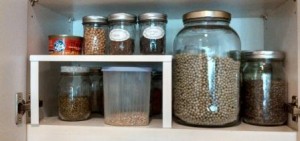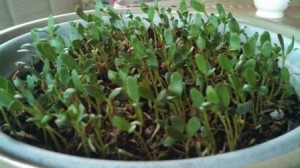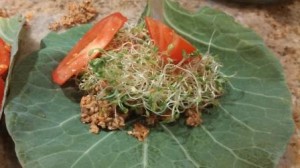1. Any Time of Year = Harvest Time
It may be spring-time now with summer fast approaching and feel like everything around is in full bloom with the fresh scent of orange blossoms, but with sprouting indoors it is ALWAYS spring growing season. Here are 9 fun-facts about sprouting at home.
With home sprouting you can harvest all year long; summer, fall, winter, and spring. You’re not growing tomatoes that require you to wait until to its above 50 degrees at night to plant the seedlings and then water diligently for months to get a summer harvest. Not only can all of the four seasons become harvest time, but your sprouts will be ready within 3 days. I’ve even harvested sweet Pea sprouts and gone skiing to make video blog post called the Adventures of the Pea Sprout. That’s seriously good news! You can harvest sprouts any time of year!
2. Seeds Are Meant for Storage
 Seeds are designed by Mother Nature for storage to store nutrients and energy for when the time is right to sprout. What that means to you is that seeds for sprouting are wonderful to have in your pantry because you can save them and sprout just the seeds you need, when you want. For example, I’ve recently been sprouting red clover and sweet pea seeds that I had stored for over three years.
Seeds are designed by Mother Nature for storage to store nutrients and energy for when the time is right to sprout. What that means to you is that seeds for sprouting are wonderful to have in your pantry because you can save them and sprout just the seeds you need, when you want. For example, I’ve recently been sprouting red clover and sweet pea seeds that I had stored for over three years.
Back in 2010 I bought a lot of seeds while shopping and preparing for the Sproutology Video. It is great because seeds cost less back then and I can confirm the shelf life of 3 to 5 years for organic seeds. Make sure you store them properly in a dry, cool dark place out of direct light and your seeds with last for years.
Enzyme inhibitors give seeds there protective coat. All it takes is water to mimic spring time and the enzymes inhibitors are broken down so that the sprouts will grow.
Scientific studies have proven that plants have the most nutritional value the first two weeks of their life. That is when the seed has germinated and sprouted!
Seeds are a true storehouse of nutrients that can benefit you when you travel too. Remember seeds are designed my mother nature for storage, and the old adage “the apple does not fall far from the tree” is true. Until a little bird picks up that seeds and flies away, or a conscious eater brings seeds with them to their travel destination.
Nothing else in your pantry can last for years and then be transformed into fresh organic food. Furthermore, even with the capacity to store for years, the seeds expand and multiply nutrient levels when sprouted. Talk about a safe, dream come true ROI in the kitchen!
3. Sprout Just the Amount You Need
No matter how many seeds you have stored, when you grow your own sprouts at home, it is easy to sprout just the seeds you want to eat that week.
In other words, you can buy in bulk and easily sprout ½ tray of wheat grass for yourself, or a whole tray for 2 people, or even multiple trays if you wanted to incorporate wheatgrass on a regular basis during a cleanse.
With sprouting at home it’s easy to control the amount you harvest by controlling the amount you start.
4. Options Greatly Expanded with So Much Variety
A home sprouter is not limited to the sprouts grown commercially available at the store.
You can usually find alfalfa sprouts and mung bean sprouts at most stores. If you’re fortunate your local supermarket or health food store may carry sunflower greens and wheatgrass. However, you probably will not find Sunflower sprouts, French lentil sprouts, sweet pea sprouts, fenugreek sprouts, radish sprouts or other varieties of seeds that you can sprout at home.
One of the best things about growing your own food is that you get to hand pick your own food. When you are the one harvesting food, you get to make sure that it’s picked at the perfect time. Alfalfa sprouts at the store are often yellowish, indicating that the chlorophyll which gives leaves green color has a low count and the baby leaves and not fully developed.
5. Environmentally Eco-Friendly
Sprouting is a technique that anyone can do to grow their own food at home. If you grow broccoli sprouts instead of buying them at the store. Think about this – you have avoided the packaging on the produce (and then from filling a landfill), the shipping from the farm to store requiring consumption of gas, all while empowering yourself as a home gardener!
Sprouting organic seeds ensures you have pure food without chemical laden preservatives. I have heard that commercial growers use a gas to pressurize big tanks to encourage mung beans to get fat juicy roots.
6. Family Fun at Home Even Without a Backyard
Sprouting at home is relatively simple with 3 basic steps; soak, rinse and harvest. It is something that even you kids can do. In the area the size of a dish strainer or even less, you can grow sprouts in your kitchen. No more excuses for not having a garden because you live in an apartment or rent a house without a big sunny backyard.
It’s widely know that cats love wheatgrass. I would love to show you how to grow your kitty some fresh grass and sprouts for your entire family!
I know a Saint Bernard that picks out fenugreek and pea sprouts from the compost pile. Everybody enjoys homegrown sprouts!
7. Saves You Cash
Growing sprouts in the home environment is a great value! If you’re looking for ways to slim down the grocery bill every month, sprouting at home is one ideal solution. One tablespoon of seeds will cost less than 50 cents and fill an entire jar with ready to eat, nutritious sprouts. Sprouting at home literally will cost you pennies per pound after you have purchased the necessary growing supplies. Being that sprouts are a concentrated nutrition source, at such a low price they really give a bang for the buck.
Everyone can afford to eat better quality nutrition with sprouts.
By sprouting at home you can grow your own wheatgrass for only 0.33 cents for a 2 oz shot. Juice bars here in California can charge up to $4.00 for that same, and you don’t know the quality of the wheatgrass. That’s a
‘Do It Yourself’ savings of over $3 per shot.
The cost benefit of growing other commercially grown sprouts such as mung bean, alfalfa, radish, and broccoli at home is equally rewarding.
8. Bring Nutritional Powerhouses Into Your House
As well as feeling absolutely fabulous in your body and full of energy, sprouts reward the mind. What other crop can you grow indoors, any time of year, with minimal space and is ready to harvest in about a week?
I personally find it very rewarding to grow my own food. However, growing food outside in the garden gets complicated when pests and other environmental factors come into play. Growing sprouts indoors in a controlled environment is so much more predictable, feasible and rewarding!
9. Don’t have to worry about dogs peeing in your garden or other pests.
If you have grown food before. I am sure you have understanding of the work involved and problems! It is not that easy to get a perfect harvest. Gardening outside you are challenged with the elements of the wild. Deer, bugs, other pests and even your pets can easily damage plants. Sprouting indoors solves those problems.
Join the Sproutology Green Thumb Membership and fast track your sprouting harvest.
The April Earth Month Sale is almost gone!
To Sprouting Seeds and Sharing Pure Food,
Sue Thomas




